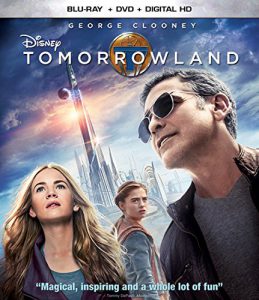The first thing I did after watching “Tomorrowland” and discussing its peculiarities with my buddy Michael was to look up articles explaining what the hell happened in the movie. (This Overmental piece is a decent one.) That’s what happens when a movie is more confusing than it needs to be, yet is filled with so many cool ideas that I can’t dismiss it from my mind.
I suppose this shouldn’t be surprising since “Tomorrowland” was written by Damon Lindelof, one of the architects of “Lost,” and Jeff Jensen, an Entertainment Weekly writer who obsessively overanalyzed “Lost” in an EW blog during the show’s run. Lindelof also wrote the mostly maligned “Alien” prequel “Prometheus,” which I found fascinating, and which whetted my appetite for next year’s “Prometheus 2.” The fact that it’s based on a Disney theme park ride and directed by animated-movie veteran Brad Bird also gives “Tomorrowland” built-in appeal.
Arguably, “Tomorrowland” shouldn’t be a movie, but rather a longer-form TV series in the vein of “Lost.” A lot of the movie’s ideas are fleshed out in Jensen’s prequel novel “Before Tomorrowland,” but that’s not a valid excuse for leaving viewers confused. I wasn’t even clear on what exactly Tomorrowland is. Another dimension? The Earth’s future? Another planet?
The movie’s introductory feel – inevitable when launching a new sci-fi world and all its attendant rules – doesn’t go away after the first act, but instead sticks around for the whole running time. It feels like a TV series pilot most of the way until it gets to a heavy-handed conclusion about how people know the world as we know it is ending yet don’t care enough to do anything about it. (In reality, lots of people care, but the world’s entrenched powers stand in the way of solutions.)
Two things tripped me up early in the film. Casey (Britt Robertson of “Life Unexpected” and “The Secret Circle”) visits Tomorrowland by touching a magic pin. Some of Tomorrowland’s people sort of react to her; others seem unaware of her presence. We later learn (and the article clarifies) that Casey was walking through an interactive advertisement for Tomorrowland.
But Frank (Thomas Robinson) gets physically transported to Tomorrowland in the 1960s via a pin, guidance from robot Athena (Raffey Cassidy) and a quirk in the “It’s a Small World” ride at Magic Kingdom. Later, in offscreen events, Frank gets banished to Earth due to an invention deemed illegal by the now-authoritarian Tomorrowland leadership — particularly the top man, Nix (“House’s” Hugh Laurie). As such, Frank becomes a curmudgeonly hermit played by George Clooney. So I couldn’t quite reconcile that Frank was truly in Tomorrowland whereas Casey was merely viewing a high-tech ad.
Secondly, Robinson and the actor playing Casey’s brother, Nate (Pierce Gagnon, from last summer’s sci-fi series “Extant”), look similar, so I thought for a while they were the same person.
That’s just at the start of the movie. After watching the whole thing, I have more questions. For example, Athena’s goal is to get Frank (a dreamer when he was a kid) and Casey (a current young dreamer) to meet each other. This is so Frank can see that Casey embodies a legitimate hope for humanity and he’ll therefore use Tomorrowland’s mothballed Earth-based portal technology to transport her to Tomorrowland. But rather than introducing the two and explaining the situation, Athena dumps Casey at the end of Frank’s driveway. This leads to a seemingly contrived action sequence where our newly united heroes fight off Nix’s bad robots from Tomorrowland.

I don’t want to get too far down the rabbit hole of explaining the plot and character motivations, especially since I might be interpreting things wrongly.
For all its flaws, I can’t dismiss “Tomorrowland” entirely because it’s a beautiful movie with many specific moments of inventiveness. So many action films nowadays are constructed in computers and unable to hide their hollowness – the unwatchable trailer of “Seventh Son” comes to mind. “Tomorrowland’s” story and futuristic world (it is another planet, the aforementioned article tells us) are intertwined, so the visuals never become empty. And even Tomorrowland’s background inventions are stunning, such as a series of floating swimming pools with a force field rather than a solid bottom, allowing someone to make a series of dives from one pool to another.
The movie has its share of traditional sci-fi tropes, including a robot-running-after-a-car scene lifted from “Terminator 2.” But these cliches are enhanced because of the original twists. Two toy store employees (Kathryn Hahn and Keegan-Michael Key), who are actually two of Nix’s robots, shoot laser guns at Casey. That’s as traditional as it gets, but then Athena unleashes a force field that gradually diminishes. So Casey, whose arm is partly in the force field, has to quickly move away from the laser blasts once her arm is free. That’s pretty cool.
These small moments of inventiveness make me wonder if the whole movie is smart and it’s me who isn’t giving “Tomorrowland” the brainpower it demands from a viewer. Lindelof’s latest seems like a repeat performance of “Prometheus” – it will probably be loathed by many but find its place as a cult classic and possibly inspire a sequel. And in all honesty, I might be back for “Tomorrowland 2.”

